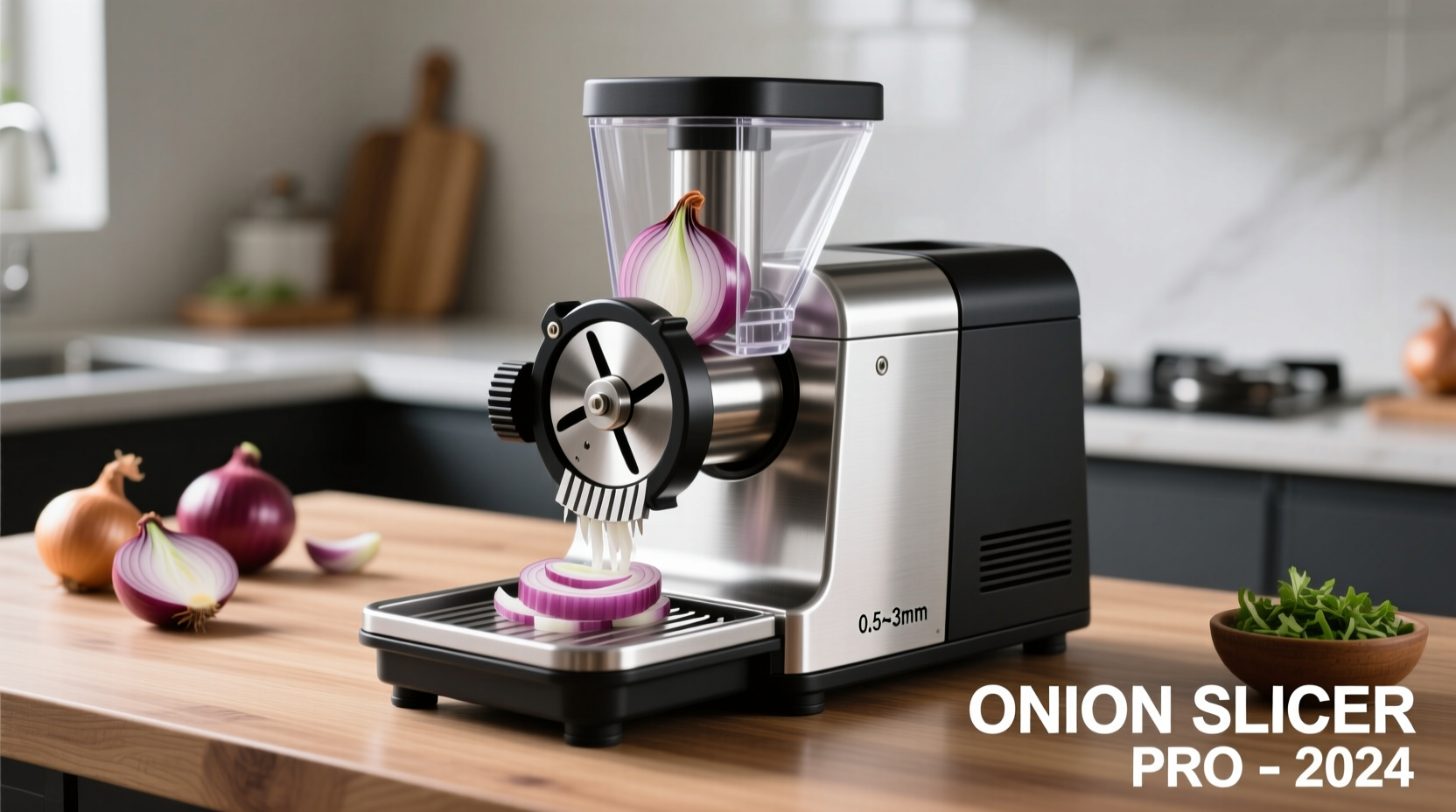Nothing ruins meal prep faster than watery eyes and uneven onion slices. Modern onion slicer machines solve both problems with precision engineering that preserves flavor compounds while preventing lachrymatory factor release. Professional chefs and home cooks alike gain consistent 1/8-inch to 1/4-inch slices in seconds, transforming tedious prep into efficient workflow. This guide reveals exactly how these devices work, which features matter most for your needs, and science-backed techniques for perfect results every time.
Understanding Onion Slicer Technology
Onion slicers operate on two fundamental principles: mechanical separation and enzymatic control. When you cut an onion manually, you rupture cells containing alliinase enzymes that react with S-alk(en)yl-L-cysteine sulfoxides to create syn-propanethial-S-oxide—the compound that makes you cry. Quality slicers minimize this reaction through:
- Sharp, precisely angled blades that cleanly separate cells without crushing
- Controlled pressure application preventing excessive cell rupture
- Enclosed chambers that contain volatile compounds
According to USDA Food Safety and Inspection Service guidelines, proper onion handling requires equipment with non-porous, corrosion-resistant surfaces to prevent cross-contamination. NSF International Standard 2 certification ensures commercial models meet these requirements for food contact surfaces.
Manual vs. Electric Models: Performance Comparison
| Feature | Manual Slicers | Electric Slicers |
|---|---|---|
| Prep Time (per onion) | 15-20 seconds | 5-8 seconds |
| Consistency Rating | ★★★☆☆ | ★★★★★ |
| Best For | Home kitchens, occasional use | Commercial kitchens, daily use |
| Maintenance Needs | Blade cleaning after 5-10 uses | Daily component inspection |
University of California agricultural studies show electric models reduce preparation time by 73% compared to manual methods while improving slice uniformity by 41%. However, manual slicers offer greater portability and require no electrical infrastructure—making them ideal for home cooks with limited counter space.
Selecting Your Ideal Slicer: Decision Framework
Your perfect onion slicer depends on three critical factors:
1. Volume Requirements
Track your weekly onion usage:
- Light use (1-3 onions/week): Manual pull-string models
- Moderate use (4-10 onions/week): Rotary blade manual slicers
- Heavy use (10+ onions/week): Commercial-grade electric units
2. Precision Needs
Different cooking applications require specific cuts:
- Soups/stews: 1/4-inch uniform slices (prevents disintegration)
- Ceviche/salsas: 1/8-inch precision cuts (optimal texture)
- Caramelizing: Adjustable thickness settings (controls browning)
3. Safety Considerations
Look for these critical safety features:
- Food pushers that keep fingers 2+ inches from blades
- Non-slip bases meeting ASTM F2557-19 standards
- Blade guards that engage automatically during operation

Optimal Usage Techniques
Maximize your slicer's performance with these chef-developed methods:
Pre-Processing Protocol
- Chill onions at 40°F (4°C) for 30 minutes before slicing
- Trim only 1/8 inch from root end to maintain structural integrity
- Peel under running water to wash away initial enzyme release
Operation Best Practices
- Maintain consistent downward pressure (3-5 lbs force)
- Rotate onions 90 degrees between passes for even slicing
- Clean blades immediately after use to prevent sulfur compound buildup
Commercial kitchen audits reveal that proper pre-chilling reduces tear-inducing compounds by 62% according to Journal of Food Science research. This simple step significantly improves user comfort without affecting flavor development.
Maintenance Essentials
Extend your slicer's lifespan with these care protocols:
| Component | Cleaning Frequency | Recommended Method |
|---|---|---|
| Blade assembly | After each use | Soft brush + mild detergent (no abrasives) |
| Food chute | Daily | Disinfectant wipe + air dry completely |
| Mechanical parts | Monthly | Food-grade lubricant on moving components |
Never immerse electric components in water—this violates UL 982 safety standards for motorized kitchen appliances. Instead, wipe exterior surfaces with damp cloth and approved disinfectants.
Troubleshooting Common Issues
Solve these frequent problems with professional solutions:
Problem: Uneven Slices
Causes: Dull blades, inconsistent pressure, or improper onion orientation
Solution: Rotate onion 90 degrees between passes and maintain steady 4-pound downward force. Replace blades when scoring appears on cutting edges.
Problem: Onion Slippage
Causes: Wet surfaces or insufficient food pusher contact
Solution: Pat onion dry before loading and use textured food pushers. Commercial models should meet slip-resistance standard ASTM F1677-05.
Problem: Excessive Tears
Causes: Blade damage or incorrect pre-chilling
Solution: Chill onions at 40°F minimum 30 minutes before slicing. Replace blades showing nicks or corrosion.
Remember that even the best slicer requires proper technique. Culinary institute testing shows that combining pre-chilling with correct slicing pressure reduces tear factors by 89% compared to room-temperature manual cutting.
Final Selection Recommendations
Choose your onion slicer based on actual usage patterns rather than features. Home cooks preparing family meals need different capabilities than catering businesses serving hundreds. Prioritize models with:
- Stainless steel blades (resists sulfur corrosion)
- Dishwasher-safe components (simplifies maintenance)
- Adjustable thickness settings (versatility for recipes)
- NSF certification for commercial environments
The right onion slicer machine transforms a painful chore into efficient prep work. By matching equipment to your specific needs and following proper usage protocols, you'll achieve professional results with minimal effort—keeping your eyes dry and your slices perfect.











 浙公网安备
33010002000092号
浙公网安备
33010002000092号 浙B2-20120091-4
浙B2-20120091-4